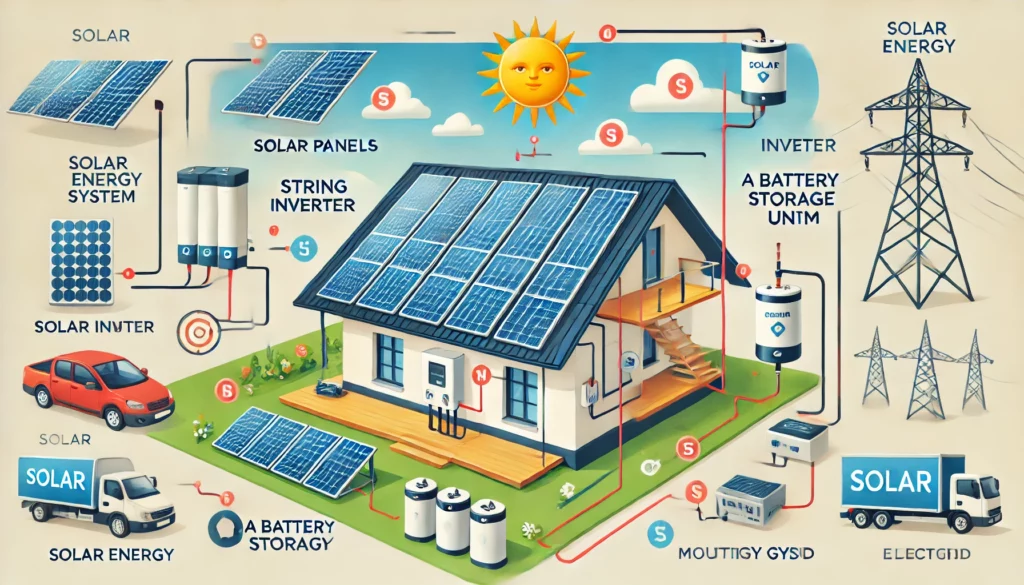Now that you’re familiar with the basics of solar energy, let’s delve deeper into the components that make a solar energy system function effectively. Whether you’re considering installing solar panels or just curious about how they work, understanding these components will empower you to make informed decisions.

1. Solar Panels: The Heart of the System
Solar panels are the most visible part of a solar energy system and play a critical role in converting sunlight into electricity.
Types of Solar Panels:
- Monocrystalline Panels: High efficiency and sleek appearance, suitable for limited spaces.
- Polycrystalline Panels: More affordable but slightly less efficient.
- Thin-Film Panels: Lightweight and flexible, ideal for unconventional installations.
Key Factors:
- Efficiency rating (percentage of sunlight converted to electricity).
- Durability and warranty.
- Performance under different weather conditions.
2. Inverters: The Brain of the System
Inverters convert the direct current (DC) electricity generated by solar panels into alternating current (AC), which powers your appliances.
Types of Inverters:
- String Inverters: A single unit connected to multiple panels; cost-effective but vulnerable to shading issues.
- Microinverters: Installed on each panel for individual optimization; ideal for shaded areas.
- Hybrid Inverters: Combine traditional inverters with battery storage capability.
Key Features to Consider:
- Efficiency and reliability.
- Compatibility with your solar panels and batteries.
- Monitoring capabilities for tracking system performance.
3. Battery Storage: Power When You Need It
Batteries store excess energy generated during the day for use at night or during power outages. While optional, they’re becoming increasingly popular as battery technologies improve.
Popular Battery Types:
- Lithium-Ion: High efficiency, long lifespan, and compact design.
- Lead-Acid: Affordable but heavier and shorter-lived.
- Benefits of Battery Storage:
- Greater energy independence.
- Ability to use solar power during cloudy days or at night.
- Backup power during grid outages.
4. Mounting Systems: The Unsung Heroes
Mounting systems ensure solar panels are securely attached to your roof or ground. They also determine the angle and orientation of the panels, impacting energy production.
Types of Mounting Systems:
- Fixed Mounts: Panels are stationary; simple and cost-effective.
- Tracking Mounts: Adjusts the angle of the panels to follow the sun; higher energy yield but more expensive.
Key Considerations:
- Compatibility with your roof type or ground space.
- Resistance to wind and weather conditions.
5. Monitoring Systems: Stay in Control
Monitoring systems provide real-time data about your solar energy production and consumption. They help identify issues early and ensure your system operates at peak efficiency.
Features to Look For:
- Easy-to-use interface, often accessible via mobile apps.
- Alerts for performance anomalies.
- Historical data for tracking long-term performance.
6. Electrical Grid Connection
If your solar system is grid-tied, it connects to the utility grid to exchange electricity. Excess energy you produce can be sent to the grid, and you can draw power when your system isn’t generating enough. This interaction is often supported by net metering, where you earn credits for excess energy.
Key Questions to Ask When Designing Your System
- How much energy do you need to generate daily?
- Is your property better suited for a rooftop or ground-mounted system?
- Do you need battery storage for your energy goals?
- What are the local regulations and incentives for solar installations?
Final Thoughts
Each component of a solar energy system plays a vital role in ensuring it runs efficiently and meets your energy needs. By understanding these parts, you’ll be better equipped to design, install, and maintain a system that aligns with your goals.
Stay tuned for Solar Energy 103, where we’ll explore how to maximize your system’s performance and tackle common maintenance challenges.
Have questions or want to learn more? Let us know in the comments!